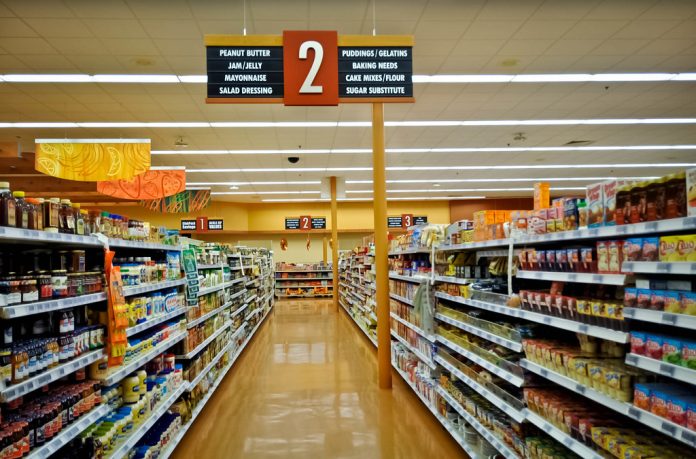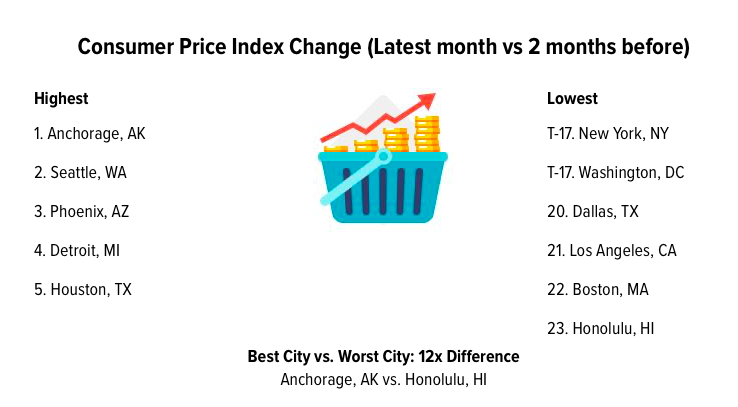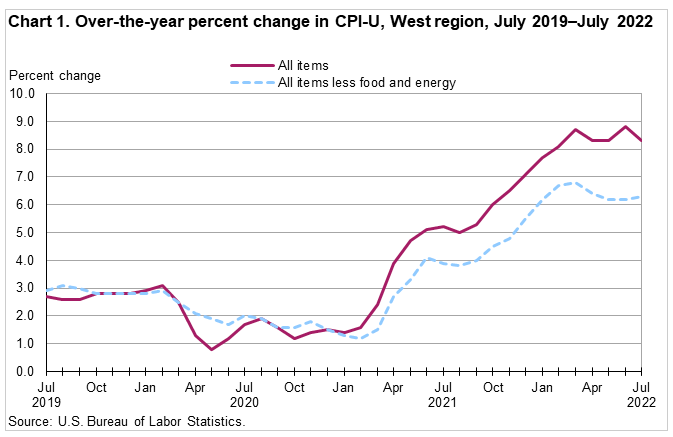
It’s hard to avoid the topic of inflation these days. Price increases on basic goods are impossible to overlook at most stores, discussion of President Joe Biden’s Inflation Reduction Act dominates the news cycle, and in conversations between family and friends, it’s become commonplace to discuss what products or services have jumped the most in price — with important distinctions emerging between cities and regions.
While data suggests that nationwide inflation rate is currently hovering at about 8.5% in comparison to a year ago, a number representing a 40-year high, cities have not been impacted equally by its growth. A recent study by WalletHub found significant differences in rates of inflation between the cities, with some surprises in regards to where inflation is growing the most.
Inflation is measured by changes to the Consumer Price Index, an indicator that is determined by assessing the change in average price for a “market basket of goods and services” over a period of time. According to the Bureau of Labor Statistics (BLS), information on these goods and services is gathered primarily from visits by BLS data collectors to some 23,000 different retail and service outlets in 75 urban areas across the country, where they keep tabs on prices on everything from apples to electronics repair.
So when year-to-year inflation was pegged at 8.5% last month, that’s because on average prices had increased that much from the previous year. However, within the “market basket” distinct differences emerge. For instance, much of the record-breaking inflation of the past year has been attributed to two major sectors of the economy: food and energy. The BLS actually estimates that if food and energy factors were removed from the basket, inflation would be at 5.9% in comparison to a year earlier, still steep, but considerably lower than current figures. In keeping with this, a recent drop of 7.7% in gas prices actually decreased inflation from where experts thought it would be for July, even though overall food costs rose by 1.1%.
Another big piece of the inflation puzzle is housing costs, which jumped an incredible amount during the pandemic, as The Urbanist has frequently noted.
Just like not all areas of goods and services have increased commensurately in price, not all metro areas have seen the same level of price increases. Looking at prices increases compared to a year ago, nationally the city that tops WalletHub’s list for inflation is Anchorage (12.4%), followed by Phoenix (12.3%), Atlanta (11.5%), and then Seattle (10.1%).
It’s interesting to note that Baltimore, which ranked just after Seattle on the list, actually had slightly higher inflation (10.6%) over the past year than Seattle. However, Seattle’s ranking was bumped up by the fact that only Anchorage had seen faster growing inflation in the past two months. Over June and July inflation increased by 3.2% in Seattle, whereas it increased by 2.6% in Baltimore during the same period. Nationwide from June to July, overall inflation for urban consumers was averaged at “effectively zero,” because of the decrease in gas prices and a few other markers.
In fact, if you remove July 2022 from consideration entirely, Seattle falls out of the top five rankings for annual inflation growth. So here in the Emerald City, this summer has been particularly punishing when it comes to inflation, whereas it might not have felt so severe elsewhere, like Los Angeles, for example, where inflation was measured at only 0.9% growth during June and July. Seattle has a become a bit of an outlier nationwide.
At this point, like many Pacific Northwest residents, you might be thinking, enough about Baltimore and Los Angeles, what about Portland? Well, Portland actually did not make it into WalletHub’s top 23 metro area rankings at all. Additional online sleuthing reveals that inflation in Portland increased by 3.16% between the first quarter of 2019 and first quarter of 2022. Now that does remove the past couple months from the equation, which possibly could have also been brutal in Portland, a hunch supported by data from BLS’s Western Office showing a steady uptick inflation across the Western region.
However, all things considered, Portland does appear to have been spared from much of the inflation that has hit Seattle, and housing is one market area in which a noticeable difference exists between the two metros. In Portland, when using the same 2019-2022 period for reference, average rent prices increased by 5% and average home purchase prices increased by 6%.
Compare that to Seattle, where housing (rental and purchase combined) is estimated to have increased by 9.4% between June 2021 and June 2022, a much shorter period. That’s a significant difference, and one for which Oregon’s success in passing policies like missing middle housing reform and statewide rent stabilization may have made an impact.
Zooming out a bit, which major American metro areas have been less impacted by inflation? Well, the results might be surprising. At the bottom of WalletHub’s top 23 list are Boston (7%), San Francisco (6.8%), Honolulu (6.8%), and New York City (6.5%).
When looking at these cities, it can be difficult to sort out exactly why certain metros are being more deeply impacted by growth in inflation than others. One of the study’s contributors, Jon Hoddenbagh, an assistant professor of economics at Johns Hopkins University, identified three major factors as driving inflation growth in the United States: supply chain disruptions, stimulus measures to combat the Covid recession, and reallocation challenges.
Of the three, reallocation challenges is the most difficult to immediately grasp as a concept. According to Hoddenbagh, reallocation challenges are basically shifts in consumer demand. During the pandemic, demand for goods increased because people were spending more time at home, while demand for in-person services plummeted. Now the demand for in-person services is returning, but supply has not been able to keep up with the shift in demand, thus creating inflation.
Maybe one of the reasons why Seattleites have been so touched by inflation in recent months is because we became so good at staying at home during the Covid pandemic, and now as we venture back into the outside world, the local economy is not ready for us. As an example, I think of Mercado Luna, a Mexican restaurant in Capitol Hill with one of the best rooftop bars in the city. A couple weeks ago, I was among a whole line of disappointed people informed by an apologetic hostess that the rooftop, which they call their “patio cielo,” was closed because of a staffing shortage. On such a warm, beautiful day it felt like huge financial mistake to leave the rooftop out of bounds, especially with a league of customers eager to access it, yet the business had no choice. Labor scarcity had tied their hands — a phenomenon that has rippling consequences across the economy.
Seattle has seen what scarcity has done to the regional housing market, and now we may be experiencing it on other economic fronts too. Let’s hope that these past two months of surging inflation taper off as the days become shorter and cooler, and we retreat back into those same winter habits that served us so well during the pandemic. We can also look to the more promising nationwide trends and expected passage of the Inflation Reduction Act, which should bring some tangible relief. The bill, which also is projected to curb climate emissions by 40% by jumpstarting America’s clean energy sector, passed the Senate on August 7th, and is headed for a vote in the House of Representatives after that chamber reconvenes on August 12th.
For now, though, little evidence suggests that Seattle will lose its distinction of being one of the cities in which inflation is growing fastest anytime soon.
Natalie Bicknell Argerious (she/her) is a reporter and podcast host at The Urbanist. She previously served as managing editor. A passionate urban explorer since childhood, she loves learning how to make cities more inclusive, vibrant, and environmentally resilient. You can often find her wandering around Seattle's Central District and Capitol Hill with her dogs and cat. Email her at natalie [at] theurbanist [dot] org.



